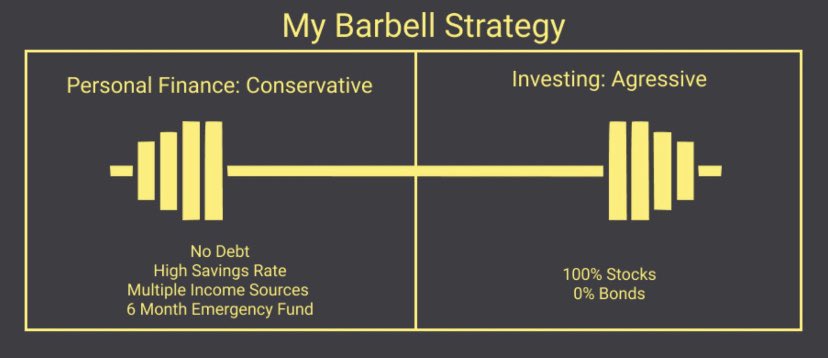The barbell investment strategy is a popular approach to investing that involves dividing your portfolio into two distinct and seemingly opposite asset classes: high-risk, high-reward investments on one end, and low-risk, low-return investments on the other. This strategy was first popularized by renowned investor Nassim Taleb in his book “The Black Swan.”
The idea behind the barbell approach is to achieve a balance between risk and reward. By investing in high-risk assets such as stocks, commodities, or venture capital funds, you are potentially able to earn significant returns. However, these types of investments also carry a high degree of risk and can result in significant losses.
To mitigate this risk, the barbell approach suggests that you also invest in low-risk assets such as bonds, money market funds, or other safe-haven investments. These assets may not provide high returns, but they can provide stability to your portfolio and protect your capital during times of market volatility.
The key to a successful barbell strategy is to maintain a clear and intentional balance between the high-risk and low-risk investments. The high-risk investments should only make up a small portion of your overall portfolio, while the bulk of your assets should be allocated to the low-risk investments.
Overall, the barbell investment strategy can be an effective way to balance risk and reward in your portfolio. By investing in a mix of high-risk, high-reward assets and low-risk, stable investments, you can potentially achieve higher returns while also protecting your capital during times of market uncertainty.
The Origins of the Barbell Investment Strategy

Nassim Taleb is often credited with popularizing the barbell investment strategy in his book “The Black Swan.” In the book, Taleb argues that traditional portfolio diversification methods, which rely on a mix of different asset classes and risk levels, are flawed because they are vulnerable to unpredictable market events.
Instead, Taleb suggests that investors should focus on a small number of high-risk, high-reward investments on one end of the spectrum, and a large number of low-risk, low-return investments on the other end. This approach creates a “barbell” shape for the portfolio, with a high degree of risk on one end and a high degree of safety on the other.
Taleb believes that this approach helps to protect investors from “Black Swan” events – rare, unpredictable, and highly impactful events that can wreak havoc on traditional portfolios. By investing in a small number of high-risk assets, investors are able to capture the potential upside of these events if they occur. At the same time, the bulk of their portfolio is invested in safe, low-risk assets, which can provide stability and protection against market volatility.
Overall, Taleb’s approach to the barbell investment strategy is focused on creating a portfolio that is both robust and resilient, able to withstand unexpected events while still providing opportunities for growth and return.
Example of Portfolio Using the Barbell Strategy
Here’s an example of a portfolio using the barbell investment strategy that equally splits the allocation between low-risk and high-risk assets, incorporating cryptocurrencies:
| Asset class | Allocation | Risk level | Expected return |
|---|---|---|---|
| High-risk | 50% | High | 20% |
| Low-risk | 50% | Low | 2% |
In this example, the portfolio is divided equally into two asset classes: high-risk and low-risk. The high-risk allocation is 50% of the portfolio and is invested in cryptocurrencies such as Bitcoin, Ethereum, or other high-potential digital assets. Cryptocurrencies are known to be highly volatile and carry a high degree of risk, but they also have the potential for significant returns. The expected return of this allocation is set at 20%.
The remaining 50% of the portfolio is allocated to low-risk, low-return assets such as stablecoins or government bonds. This allocation is meant to provide stability and protection against market volatility, with an expected return of 2%.
Overall, the expected return of the portfolio is calculated as a weighted average of the expected returns of each asset class:
Expected portfolio return = (Allocation x Expected return) + (Allocation x Expected return)
Expected portfolio return = (0.50 x 20%) + (0.50 x 2%)
Expected portfolio return = 11%
In this example, the portfolio is expected to provide an overall return of 11%, with a significant potential for higher returns from the cryptocurrency allocation and stability from the low-risk allocation.
It’s important to note that investing in cryptocurrencies is highly speculative and carries significant risk. The actual performance of this portfolio may vary based on individual circumstances and market conditions. Additionally, past performance is not indicative of future results, and investors should always do their own research and seek professional advice before making investment decisions. The 50/50 split of the allocation between high-risk and low-risk assets can be adjusted based on individual risk tolerance and investment goals.
Conclusion
In conclusion, the barbell investment strategy is a compelling approach for investors looking to balance risk and return in their portfolios. By allocating a significant portion of the portfolio to high-risk, high-reward assets, and balancing it with low-risk, stable assets, investors can potentially achieve attractive returns while minimizing downside risk. A great way to further research how to invest is by taking a look at investment strategies on the ASX with ASR.
An example of the barbell strategy in action with stocks can be seen in the portfolio of renowned investor Nassim Taleb, who is known for advocating the barbell strategy. Taleb’s portfolio consists of a combination of high-risk investments in a small number of individual stocks, and low-risk investments in US Treasury bonds. This strategy has allowed Taleb to potentially benefit from the upside potential of a few high-growth stocks, while still providing downside protection through the safe-haven asset of Treasury bonds.
Looking ahead, the barbell strategy is particularly attractive in the current investment climate, where many traditional asset classes are facing significant headwinds due to low interest rates and high valuations. With the potential for increased market volatility and uncertainty, a barbell strategy can provide a sound approach to managing risk and return.
Moreover, with the rapid growth of digital assets, cryptocurrencies can offer a high-risk, high-reward opportunity for investors looking to adopt the barbell strategy. As the adoption of cryptocurrencies continues to grow and mature, this asset class can potentially provide significant returns for investors, especially those who adopt a barbell strategy with a diversified portfolio.
Overall, the barbell strategy offers a compelling approach for investors to balance risk and return in their portfolios, and with careful implementation and active management, it has the potential to deliver attractive returns in the coming decade.
n.b: this is not financial advice
